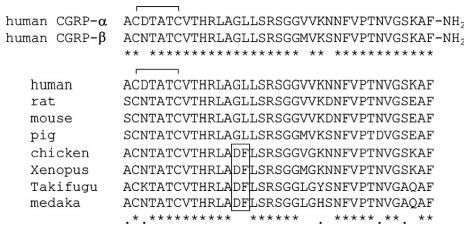|
|
| Product Name: | BETA-CGRP, HUMAN | | Synonyms: | β-CGRP (huMan)
CGRP-II (huMan);H-ALA-CYS-ASN-THR-ALA-THR-CYS-VAL-THR-HIS-ARG-LEU-ALA-GLY-LEU-LEU-SER-ARG-SER-GLY-GLY-MET-VAL-LYS-SER-ASN-PHE-VAL-PRO-THR-ASN-VAL-GLY-SER-LYS-ALA-PHE-NH2;CGRP HUMAN;CGRP-II;CGRP-II (HUMAN);CALCITONIN GENE RELATED PEPTIDE;CALCITONIN GENE RELATED PEPTIDE HUMAN;CALCITONIN GENE-RELATED PEPTIDE-II, HUMAN | | CAS: | 101462-82-2 | | MF: | C162-H267-N51O48S3 | | MW: | 0 | | EINECS: | | | Product Categories: | | | Mol File: | Mol File | ![BETA-CGRP, HUMAN Structure]() |
| | BETA-CGRP, HUMAN Chemical Properties |
| storage temp. | −20°C | | solubility | Soluble in DMSO | | Sequence | H-Ala-Cys-Asn-Thr-Ala-Thr-Cys-Val-Thr-His-Arg-Leu-Ala-Gly-Leu-Leu-Ser-Arg-Ser-Gly-Gly-Met-Val-Lys-Ser-Asn-Phe-Val-Pro-Thr-Asn-Val-Gly-Ser-Lys-Ala-Phe-NH2(Disulfide bridge: Cys2-Cys7) |
| | BETA-CGRP, HUMAN Usage And Synthesis |
| Gene, mRNA, and precursor | The human CGRP-α gene (CALCA), located on chromosome 11 (11p15.2), consists of six exons. CGRP-α
mRNA is synthesized by the alternative splicing of exons
1, 2, 3, 5, and 6 of the CALCA gene. Exon 4 codes for calcitonin (CT). The human CGRP-β gene (CALCB), located
in the vicinity of CALCA on chromosome 11 (11p15.2),
consists of five exons. CALCB encodes only CGRP-β
and does not contain a CT-like sequence. The sequence
and structure of CALCA are well conserved among all
vertebrate species. CALCB is preserved in primates and
in rodents. In fish, the medaka also possesses two types
of CGRP gene (cgrp1 and cgrp2), but medaka cgrp2 is
not the ortholog of mammalian CALCB. Mammalian
CALCA and CALCB are considered to have been generated by tandem duplication that occurred later than the
separation of the Euarchontoglires lineages, for they are
located in the same chromosome. In contrast, medaka
cgrp genes are located in separate chromosomes, indicating that they were produced by the teleost-specific whole
genome duplication that occurred after the separation of
the teleost lineage. | | Receptors | The functional CGRP receptor is derived from the calcitonin receptor-like receptor (CLR), whose phenotype is
determined by coexpression with the receptor activitymodifying protein (RAMP). The coexpression of CLR
with RAMP1 results in the CGRP receptor, whereas coexpression with RAMP2 or RAMP3 produces the receptor
for adrenomedullin, another member of the CGRP family. CLR is a seven-transmembrane-domain GPCR consisting of 474–548 aa residues in mammals; it shares
55% sequence identity with the CT receptor. RAMP is a
single-transmembrane accessory protein that regulates
the activities of several GPCRs. Besides contributing to
receptor specificity, RAMPs are required for the transportation of CLRs from the endoplasmic reticulum to the
plasma membrane. Three types of RAMPs consisting of
148–175 aa residues exist in mammals, and five types
are identified in teleost fish. The functional CGRP receptor requires another accessory protein, the receptor component protein (RCP). The CT receptor (CTR)/RAMP1
complex, which is known as the amylin receptor, is also
reported to be responsive to CGRP. | | Agonists and Antagonists | Recombinant human CGRP-α, amylin. CGRP8–37 fragment, BIBN4094BS, MK3207, BI44370A,
SB-273779, WO98/11128, and BMS-927711. | | Biological functions | CGRP exerts vasodilation in the microvasculature in
the brain, heart, gastrointestinal system, limbs, and skin.
CGRP, released from the terminal of sensory nerves,
binds its receptor in the vascular smooth muscle cells
and causes vasodilation. CGRP also has a cardioprotective role against ischemia/reperfusion injury. CGRP is
likely to be involved in various biological actions; its plasma level increases during pregnancy in rats, it
inhibits gastric acid secretion in rats and dogs, and the
gene transfer of CGRP restores erectile function in aged
rats. | | Clinical implications | CGRP is actively studied in relation to migraines. The
jugular level of CGRP is increased during migraine
attacks, and intravenous CGRP administration induces
a migraine-like headache in humans. CGRP receptor
antagonists are considered to be effective for the treatment of migraines. Increased plasma CGRP levels are
also observed in myocardial ischemia and sepsis. CGRP
may be implicated in Raynaud’s disease, the syndrome
characterized by severe peripheral vasospasms. The
administration of CGRP leads to peripheral vasodilation
and promotes the healing of ulcers in patients with this
disease. | | Synthesis and release | CGRP is synthesized in a variety of central and peripheral neurons, and is packaged into vesicles that are transported to nerve terminals. CGRP release from sensory
nerve terminals is stimulated by vascular wall tension,
steroids such as estrogens and androgens, bradykinin/
prostaglandins, and endothelin. During a migraine, the
activation of trigeminal nerves stimulated by inflammatory substances from the cerebrovasculature leads to
the release of CGRP. In the gastrointestinal system, the
synthesis and release of CGRP are triggered by the activation of the capsaicin receptor TRPV1 in the sensory
nerves. However, the exact mechanism of CGRP release
is largely unknown. | | Description | CGRP is a vasodilative neuropeptide synthesized mainly
in the central nervous system. It is a transmitter of nociceptive signals in relation to migraines. The presence of CGRP-α (or αCGRP) mRNA formed
by alternative splicing from the calcitonin gene
(CALCA) was reported in 1982, and it was isolated in
1984 from human medullary thyroid calcinoma. CGRP-β (or βCGRP) was identified by human genome
analysis in 1985. | | Structure and conformation | Two types of CGRP (CGRP-α and CGRP-β) are conserved among several mammalian species in Euarchontoglires. Human proCGRP-α and mature CGRP-α consist of
128 aa and 37 aa residues, respectively. Human
proCGRP-β and mature CGRP-β consist of 127 aa and
37 aa residues, respectively. The sequence identity
between CGRP-α and CGRP-β is 92% in the human and
97% in the rat. The sequence of CGRP-α is highly conserved among vertebrates from fish to mammals. Glycine-14 and leucine-15 sequences are conserved in mammalian CGRP-α peptides, whereas aspartic acid and phenylalanine are conserved in the region of
nonmammalian CGRPs. CGRP-α and CGRP-β both contain a ring structure
formed by the single disulfide bond between the
cysteine-2 and cysteine-7 residues. The carboxyl end is
amidated. CGRP-α, Mr. 3789.4; CGRP-β, Mr. 3793.4. pI 5.3.
Soluble in water and physiological saline solution.
 |
| | BETA-CGRP, HUMAN Preparation Products And Raw materials |
|